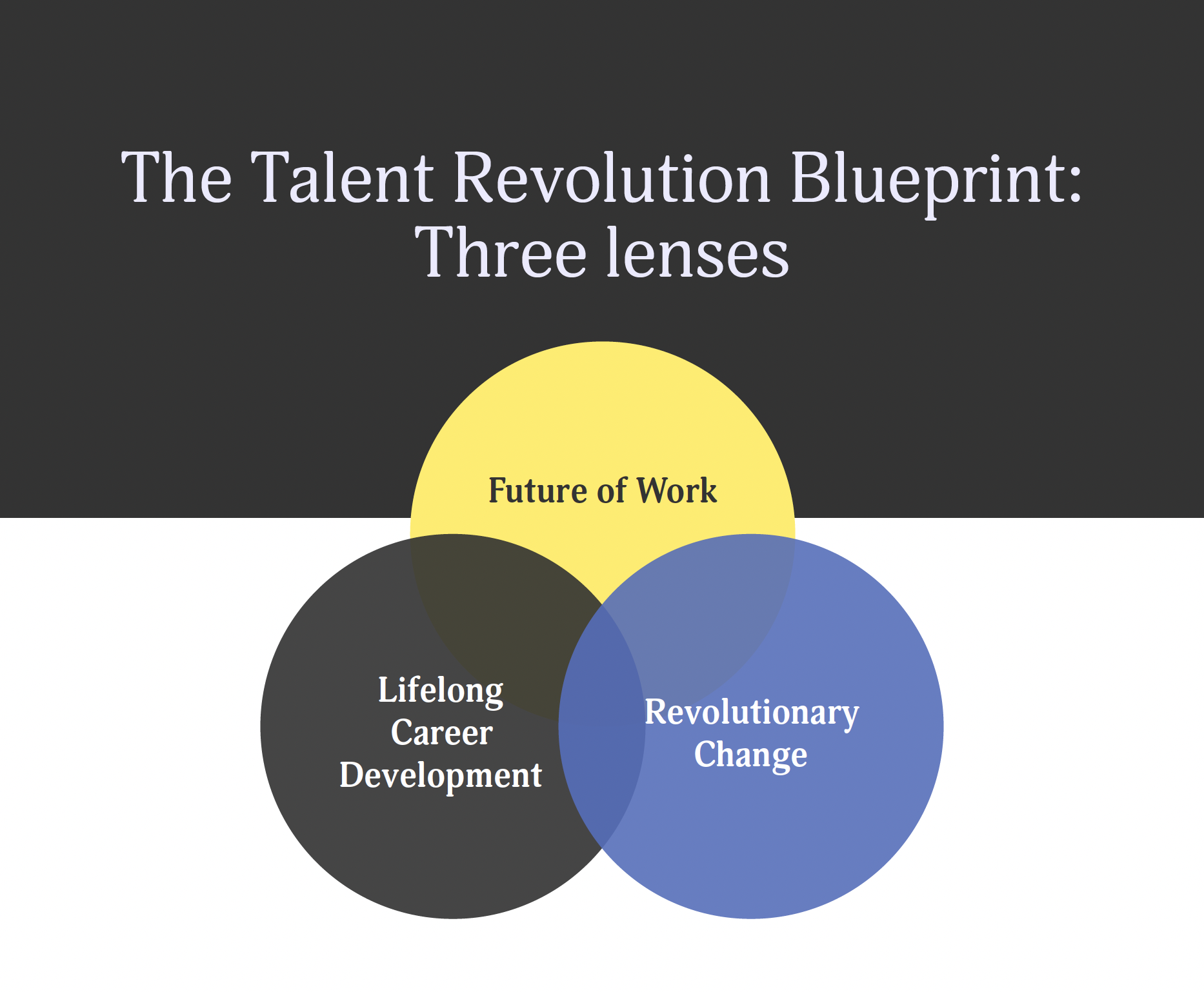The complex challenges facing today’s changing world of work call for innovative, integrated, and responsive solutions.
Since our founding in 2011, Challenge Factory has been using a proven approach, what we call the Talent Revolution Blueprint, for building workforce architecture solutions.
Based on three lenses that drive human-centric and evidence-based learning, insight, and impact, the Talent Revolution Blueprint was designed long before the COVID-19 pandemic upended our lives and work—but it has only become more valuable as we all chart our way through disruption and recovery.
First, let’s take a look at the three lenses that form the pillars of the Talent Revolution Blueprint. Then, we’ll explore how they are used together and where the unique workforce architecture value of this approach is found. Lastly, in the case study that follows, we apply the Talent Revolution Blueprint to a real-world challenge that we’ve all had to grapple with: getting through the COVID-19 pandemic.
What is it: The three lenses

Future of Work
It’s time to toss out prescriptive, derivative approaches to the Future of Work. The ‘Five Trends’ or ‘Ten Tips’ for preparing for the Future of Work will not lead us where we need to go. They signal decisions and choices that other people would make about our future, work, and lives.
Instead, we need to ask what we want the world of work to be for ourselves, our organizations and communities, and our children—and how we can go about building that future. This is about shaping the Future of Work, not preparing for it.
Revolutionary change
Widescale or system-wide change offers opportunity even when it overwhelms us with uncertainty or disruption. Sometimes everything changes all at once. Sometimes radical, unstoppable shifts take place over time but still come to be experienced as shocks to our system. Both are revolution.
We need to ask how we can learn from revolutionary change, how we can apply it to the world of work, what tools and methodologies we can use to embrace and foster drivers of change, and how we can adopt a resilient and open mindset so we are leading revolution rather than being swept away by it.
Lifelong career development
In Canada, careers education, planning, and learning are often associated narrowly with helping students navigate to post-secondary education. But career development is much more than this. It’s a lifelong process that everyone engages in, whether they know it or not, and includes paid and unpaid activities at all life and career stages. Career development is also a rich, professionalized field of practice, theory, service providers, and experts.
While career ownership ultimately rests with the individual, managers and employers have roles to play as career enablers and supporters. This means we need to ask how individuals and their skillsets connect to labour market needs, how career expectations and aspirations (e.g., individuals’ interests, values, and goals) can align with organizational expectations and needs, and where opportunities exist to advance growth, success, and happiness.
The blueprint: How we use it
The Future of Work, revolutionary change, and lifelong career development form the foundation of all the workforce architecture that Challenge Factory does in our research, learning/training, and consulting groups. In every activity or circumstance, with every client, on every project, we chart our path through the challenges and complexity to solutions by drawing on these three lenses.
So how do we put the Talent Revolution Blueprint to use?
Move into the overlaps
On their own, each of the lenses enable strategies for tackling the changing world of work. However, the true workforce architecture power of the Talent Revolution Blueprint is found in the overlaps between them.
We look at where research needs to be advanced that better uses, advances, and integrates the knowledge of each. We look at where our consulting clients—industry associations, policymakers, post-secondary institutions, corporate teams—will benefit from adding lifelong career development and revolutionary change lenses to their succession planning, talent recruitment, or leadership development. Rather than only drawing on change management, we look at how our learning/training curricula can use a combination of revolutionary change, a proactive approach to shaping the Future of Work, and a lifelong approach to career development.
The goal and the value is found in cross-pollination, making better connections, and pulling threads together that lead to workforce architecture innovation and creativity in unexpected ways.
Embrace continuous improvement
The Talent Revolution Blueprint requires flexibility, adaptability, and collaboration so that it can be applied to the many different contexts in which workforce architecture is needed today. Essential to sustaining this capacity is committing to continuous improvement.
Each of the three lenses are evolving rapidly, with new research and tools being developed and their respective bodies of knowledge expanding every day. Building continuous improvement into both our internal strategies and the solutions we are innovating for clients ensures that Challenge Factory’s work remains forward- focused, resilient, and ahead of trends.
Moving into the overlaps reinforces the value of embracing continuous improvement, while embracing continuous improvement pushes us more effectively and actively into those overlaps—where workforce architecture is at its most innovative and integrated.
Why we use it
There are several important benefits to using the Talent Revolution Blueprint. These give us the extra value—distinct from other human resources, career, and workforce strategists—that we need to tackle challenges about the world of work and create the best possible solutions for our clients.
The Talent Revolution Blueprint allows us to:
- Ask better questions.
- Be prepared for complexity (see it as an opportunity rather than an obstacle).
- Tell nuanced and engaging stories in accessible ways.
- Provoke transformation rather than artificial or stopgap measures.
- Operate in cross sectoral spaces, with cross-sectoral partners.
Using the three lenses in combination gives us access to better data, research, tools, methodologies, insights, and perspectives to be able to productively decode the world of work around us.
They anchor our workforce architecture by equipping us to consistently forecast what’s happening now, what’s likely to come next, how we know what we should be paying attention to (and what we shouldn’t), and what’s needed to succeed and thrive in short and long time horizons.
